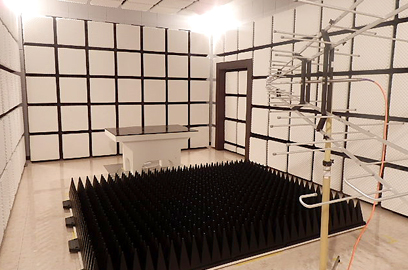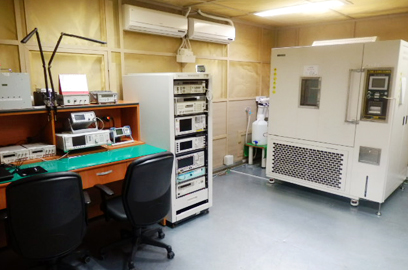Main business
 About Us
About Us
 Main business
Main business
EMC(Electromagnetic Compatibility)
JNDL is an internationally certified testing institute which provides a total solution for the product from the initial development stage to the certification and post-management stage, based on rich experience and strong technological power in relation to EMC certification applying to all electronic and electric devices.
EMC certification test
EMC is divided into electromagnetic interference (EMI) and electromagnetic susceptibility (EMS). EMI prevents electromagnetic interference to other devices by minimizing unwanted electromagnetic waves that are emitted to outside of the device. EMS(Electromagnatic Susceptibility), also called Electromagnetic Immunity, enables a device to normally work even if affected by electromagnetic interference from an external source.
Equipment subject to EMC test
Safety of all the information and communications equipment released in the market including wired/wireless devices, industrial equipment, home appliances, medical devices, lighting equipment, and audio equipment shall be proved through electromagnetic tests.
EMC test items
EMI
- Conducted Emission
- Radiated Emission
- Power Disturbance
- Harmonics & Flicker
EMS
- Electrostatic Discharge
- Radiated Susceptibility
- Conducted Susceptibility
- burst
- surge
- Power Frequency Magnetic Field
- Voltage Dips & Interruption
EMC certification support
KC
KoreaCE
EuropeFCC Part
15, 18
USAVCCI
JapanCCC
ChinaIC
CanadaA-tick, C-tick Australia
-

Compact Chamber(3M)
-

Shielding room for conduction test
-

EMS shield room
-

Open Site (10m Outdoor Test Site)
-

Compact Chamber for RE and RS
-

RS Test Equipments
Telecom/RF (Wired/wireless communications)
Wired/wireless devices shall be tested and certified in accordance with relevant technical standards and laws in order to protect public networks and reduce risk of human injury.
Wireless devices
The purpose of RF tests is to efficiently use radio spectrum and secure high performance and quality of radio frequency-based wireless devices, thereby ensuring the reliability of such devices in relation to human safety and maintaining order of domestic radio frequencies.
Equipment subject to RF test
-
Terminals, modules, relays, and base stations supporting LTE/CDMA, and Wibro/Wimax
-
Extremely low-power wireless devices, specific low power radio equipment, Family Radio Service (FRS)
-
RFID/USN devices and wireless LAN, Bluetooth modules and devices
-
Other wireless equipment
RF test items
- Maximum Output Power
- Occupied Bandwidth
- Frequency Stability
- Spurious Emission
- Adjacent Channel Leakage Ratio
- Receiver Supurious Emission
Wired devices
The purpose of telecom tests is to protect facilities-based telecommunications networks from electrical or mechanical risks and ensures user safety, rights and interests.
Equipment subject to telecom tests
-
Wired phones, faxes, credit card readers, modems, and routers
-
All-in-one terminals with a calling function, exchangers, and key-phone systems
Telecom/RF certification support
KC
KoreaR&TTE
EuropeFCC Part
15, 22, 24, 68
USAJATE&TELEC
JapanSRRC/NAL
ChinaCountries where regulation of wireless devices is conducted
-

RF test room
-

Telecom test room
Safety (Electrical safety)
Safety tests are performed to ensure electrical and mechanical safety of electrical/electronic and mechanical equipment and prevent their damage from a number of risk factors such as an electric shock, fire, or explosion. JNDL provides standard certification service meeting various requirements of the customer, with our state-of-the-art facilities to test the device in accordance with safety standards of main export markets around the world.
Equipment subject to safety tests
-
IT equipment, power supply units, home appliances, industrial controllers, and lighting equipment
-
Audio & Video & TV, machinery, medical devices, fire-fighting equipment
Safety test items
- Rated power input test
- Abnormal operating condition test
- Temperature and heating test
- Leakage current test
Reliability
Reliability tests are divided into environmental tests (geological and climatic characteristics considered) safety tests, noise input tests, and mechanical tests to secure high quality, performance, and safety from the initial development stage of part, materials, or products to the final completion stage.Aside from standard certification, reliability tests that consider product features are required by importers or manufacturers to importing from/exporting to domestic/overseas companies. This test serves as a reference of quality verification.
Equipment subject to reliability test
-
IT equipment, audio/video devices, medical devices, and home appliances
-
Automobile electronics, railway/vessel electronics
Reliability test items
- Environmental test (Temperature/humidity test, temperature/humidity cycle test, thermal shock test, and neutral salt spray test)
- Safety test (Input test, power consumption test, insulation resistance test, high potential voltage test (or puncture test), leakage current test, power frequency variations test)
- Noise test (ESD test, lightning test, over voltage test, and short interruptions and voltage variation immunity test)
- Instrumental test (Free fall test and vibration test)
- Special test (life-span test, dust test, and water-proof test)


